- Administrator
- Albums and Singles
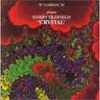 No matter what a person thinks of the music of Current 93, it must be recognized that David Tibet has always been a champion of other visionaries, whether they be in the realm of music, literature, or in the case of Harry Oldfield, science and invention. The "Current 93 present" series is just one example of Tibet’s gift as a curator. In this series of discs (now out-of-print) he brings to light and showcases talents who might not otherwise have received outside their own circles. While some have been more renowned, such as Shirley Collins and Tiny Tim, others like Sveinbjörn Beinteinsson, the Venerable 'Chi.med Rig. 'dzin Lama, Rinpoche and Harry Oldfield have received less notice. Oldfield’s work in the development and application of electro-crystal therapy is fascinating, and this musical artifact, created in accordance with his research is a wondrous, mutli-facedted specimen.
No matter what a person thinks of the music of Current 93, it must be recognized that David Tibet has always been a champion of other visionaries, whether they be in the realm of music, literature, or in the case of Harry Oldfield, science and invention. The "Current 93 present" series is just one example of Tibet’s gift as a curator. In this series of discs (now out-of-print) he brings to light and showcases talents who might not otherwise have received outside their own circles. While some have been more renowned, such as Shirley Collins and Tiny Tim, others like Sveinbjörn Beinteinsson, the Venerable 'Chi.med Rig. 'dzin Lama, Rinpoche and Harry Oldfield have received less notice. Oldfield’s work in the development and application of electro-crystal therapy is fascinating, and this musical artifact, created in accordance with his research is a wondrous, mutli-facedted specimen.
Tibet was first introduced to Oldfield's work by Hilmar Örn Hilmarsson (or HÖH who also mixed one of the most beautiful tracks on this release) while in Reykjavik, Iceland back in 1986. The work of Harry Oldfield is very wide ranging, but he is perhaps most well known for his pioneering work in developing non-invasive methods for the analysis and balancing of the human energy field. Chief among these methods is his innovative combination of electromagnetism with quartz crystals to create what he has called "Electro-Crystal Therapy". There is nothing New Age about this practice. Yes, his work has been on the fringe of science, but it has gained recognition in it's orthodox circles. After all crystals have been used for many advanced technologies including radio and computers to microphones, speakers, and lasers. That stimulating them with pulses of high frequency electricity could have a healing effect should come as no surprise. His therapy involves placing crystals in tubes containing a conductive electrolyte brine solution, and putting those tubes around certain points of the body. The tubes are then attached to an electromagnetic generator that administers electrical frequencies to the crystals. These frequencies, interacting with the crystals, then balance and normalize the human or animal energy system. Oldfield likens this process to receiving a "molecular massage."
A similar procedure has been used by Harry to record the crystal music on this disc. Different crystal specimens were used in varying combinations with two Electro-Crystal Therapy sound generator units. Special frequencies were then pulsed into them, and the sounds were recorded. Five of the songs on the disc were mixed out of the resultant recordings by Ken Thomas, and a sixth by HÖH, the other twelve tracks are strict examples of the recordings of the crystal combinations. However, nothing else has been mixed into these tracks. All a listener gets is the sound of crystals pulsed with electromagnetic energy. David Tibet and John Balance were both present when these recordings were made.
So what does it all sound like? Fans of high-pitched sine waves and crackling static will find much to love here. There isn't much going on in the low-end spectrum. Although some songs drone and some create a good backdrop for other activities or just spacing out to, it's not very ambient. These are the sounds of crystals singing. The mixed tracks are the easiest ones to listen to. My one issue with the album is that the unmixed tracks just containing the pure crystal recordings are interspersed with the tracks that are mixed in some manner, that latter having more song like qualities. I feel it would have been better if the six "songs" were first, and the twelve examples of straight up crystal recordings comprised the last section. But that is a minor complaint for such an innovative record.
On "One" it almost sounds as if the quartz is whistling. As if wind is rushing through some icy cavernous tunnel. "Three," also mixed by Ken Thomas, is very odd. Ascending and descending fractal spirals ripple in and out of each other. It sounds like some of these crystals have been run through the up-and-down pulse of a slow flanger or phase shifter. I don't know if they have been or not. I do know that my favorite track, "Energy Is Eternal Delight," mixed by HÖH, was treated with various rhythmic delays. In the liner notes he wrote that "no attempts were made to have the end results aesthetically pleasing" the main principal being to emphasize the character of the crystals being used, but this is the track that turned out to be the highlight of the album for me. That such a production would be the work of Hilmar is easy to believe. This song is what the Earth sounds like if a moment is taken to listen to it breathe. It starts off soft, slowly undulating, cycling through a passage, breathing in and breathing out, then the icy crystalline structures emerge. The song is an abstract architecture of natural lines, latticework, striated surfaces, and interior coagulations. I have returned to this album, and to this song in particular, over and over again throughout the years. It does for sound what a prism does for light.
The fact that crystals can be used as a musical source begs the question: Why aren’t more musicians using these techniques to create eerie, beautiful, mesmerizing, otherworldly music?
samples:
 
Read More
- Administrator
- Albums and Singles
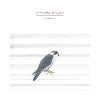 Lawrence English's latest release arrived at the perfect time for me, as I am in the throes of both a lengthy fascination with drone and a budding obsession with the New York Review of Book's masterfully curated publishing imprint.  The Peregrine is based on an "elegantly misanthropic" 1967 non-fiction work of the same title in which enigmatic writer/bird-watcher J.A. Baker becomes obsessed by a pair of falcons and stops identifying with humanity.  Befitting an album inspired by birds of prey, Lawrence's aesthetic here is considerably heavier and grittier than his characteristic pastoral ambiance.  In fact, this may be the first "difficult" Lawrence English album, but it is also a pretty stunning one.
Lawrence English's latest release arrived at the perfect time for me, as I am in the throes of both a lengthy fascination with drone and a budding obsession with the New York Review of Book's masterfully curated publishing imprint.  The Peregrine is based on an "elegantly misanthropic" 1967 non-fiction work of the same title in which enigmatic writer/bird-watcher J.A. Baker becomes obsessed by a pair of falcons and stops identifying with humanity.  Befitting an album inspired by birds of prey, Lawrence's aesthetic here is considerably heavier and grittier than his characteristic pastoral ambiance.  In fact, this may be the first "difficult" Lawrence English album, but it is also a pretty stunning one.
I have always been a fan of English's work, but his consistency is something of a mixed blessing.  He is reliably excellent and is undeniably one of the best choices for warm and immersive ambient drone, but that particular aesthetic has become pretty damn over-saturated in recent years.  Consequently, I am most interested in his departures from that comfort zone these days.  As far as such departures go, The Peregrine is an even more radical statement 2009's rather dark It's Up To Us To Live, as it is incredibly harsh and under-processed by Lawrence English standards.
Curiously, the base components of English's pleasantly shimmering sound beds remain mostly intact, but the atmosphere has been warped into something atypically stark, wintry, and forlorn (most conspicuously on the opening "The Hunting Life").Like a film director changing the whole complexion of a scene with a color filter, English has turned "pleasant" into "unsettling" with subtle dissonances, murkier fidelity, increased high-end sizzle, and unpolished edges (all enhanced, no doubt, by the vinyl medium). The effect is surprisingly dramatic and weirdly "punk"–I imagine this is how Lawrence would sound if he showed up at a basement party with only a synth and a mixer and blasted out a set through a couple of Marshall stacks.
My favorite two pieces are probably "The Roar Ceasing" and "Heavy Breath of Silence," but they only stand out from the rest of album because they both feature extremely low bass note progressions beneath their cold and bleak synth washes, making them feel a bit more melodic and kinetic than the surrounding material.  My ears might just be happy to have a very minor respite from the unforgiving small-scale existential horror of the rest of the album though.  Also, focusing on specific songs here is a fool's game: The Peregrine feels very much like an epic suite rather than a collection of individual pieces, so the arc and cumulative power is far more significant than the individual sections.
This is a very daring, minimal, and striking effort and I find myself increasingly marveling at its very existence.  I did not think English was capable of something so arctic, naked, and unrepentantly prickly.  He blindsided me here.  As a pre-existing fan, I love this album precisely because of that–English jettisoned almost everything that I enjoy and associate with him (tranquil beauty, crystalline production, amniotic warmth, etc.) and still managed to turn out something deeper, more successful, and more visceral that I ever would have expected.  Anyone new to Lawrence should probably dip their toes into something like Kiri No Oto or A Colour For Autumn before taking a chance on this more dark and primal side of his art, but this is definitely a significant peak in his oeuvre and a resounding artistic success.
Samples:
 
 
Read More
- Administrator
- Albums and Singles
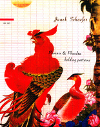 This performance was commissioned for 2009's A Thing About Machines festival, an event devoted to the theme "Spaces Speak."  Such a theme is right up Janek's alley, as he has long been interested in the role that architecture plays in the listening experience.  He is also fascinated by the fact that we are constantly immersed in a sea of unnoticed waves and transmissions, so he artfully combined them by transmitting some components of the piece to radios distributed to audience members throughout the concert hall.  In album form, sadly, Janek's clever spatial and acoustic manipulations are unavoidably lost, but Phoenix & Phaedra is still an enjoyably warm and crackling soundscape by one of the world's finest sound artists.
This performance was commissioned for 2009's A Thing About Machines festival, an event devoted to the theme "Spaces Speak."  Such a theme is right up Janek's alley, as he has long been interested in the role that architecture plays in the listening experience.  He is also fascinated by the fact that we are constantly immersed in a sea of unnoticed waves and transmissions, so he artfully combined them by transmitting some components of the piece to radios distributed to audience members throughout the concert hall.  In album form, sadly, Janek's clever spatial and acoustic manipulations are unavoidably lost, but Phoenix & Phaedra is still an enjoyably warm and crackling soundscape by one of the world's finest sound artists.
Despite the fact that this is a live performance commissioned to meet specific conceptual criteria, Phoenix & Phaedra Holding Patterns is very much a serious musical composition (rather than a mere installation or performance experiment) and a major work in Schaefer's discography.  In fact, he wrote it to celebrate the birth of his son (Phoenix).  Unfortunately, I have no idea how Phaedra fits into Janek's vision, as her story involves false accusations of rape, sea monsters, and suicides, none of which seem to occur here.  Instead, the six pieces here are largely based on decidedly less lurid Shruti box drones.  Schaefer is far too idiosyncratic to make a conventional drone album though, especially since much of his notoriety stems from innovative use of found sound and his singular talent for modifying record players.  Given that, it is no surprise that this material is pleasingly varied and unpredictable, but it is pretty astonishing how "musical" Schaefer is able to be without much in the way of "real" instrumentation.  I imagine it is not easy to construct a coherent, engrossing, and constantly shifting hour of music with some records, some field recordings of birds and machinery, and a box that makes a drone (used far more sparingly than I would expect).
The strongest and most immediately gratifying moments come when Janek makes unexpected textural or melodic detours, such as the "dying music box in a wind storm" interlude in the brief "Eyrie of the Phoenix."  More importantly, however, there is a very exacting mind dictating the ebb and flow of all the various sounds, so this isn't a drone album with some unexpected elements so much as an absorbing, surreal, and oft emotionally resonant aural narrative.  Happily, Schaefer usually displays a great deal of tact and nuance too, eschewing conventional build-ups and climaxes in favor of oases of blissful shimmering nirvana ("Red Plumes," for example) linked by enigmatic passages of collaged field recordings.  The overall experience is akin to a good story elusively unfolding as a series of fragmented impressions.
The only minor issues that I have with this album are that some of the Shruti box-centric passages are not uniquely Janek Schaefer-esque and that it is slightly more successful as an artistic statement than as a piece of music.  The music is certainly quite good, but a large part of my enjoyment stemmed from an intellectual appreciation for Janek's high-wire act of weaving a complex and compelling tapestry of disparate threads together without ever using density as a crutch.  Schaefer's mastery of his craft is impressive–it is very rare to hear abstract music that is this deliberate, uncluttered, and clear.   I definitely wish I had caught the actual event, but this makes for a very rewarding consolation prize.
Samples:
 
Read More
- Administrator
- Albums and Singles

Prior to hearing Golden Retriever, the idea of a bass clarinet/modular synthesizer duo would have seemed uniquely terrible to me.  That initial prejudice was not entirely wrong, as Jonathan Sielaff and Matt Carlson can be a rather tough ride during their wilder improvisations, but this 2010 release is pretty spectacular and faultless.  As improbable as such a thing may seem, Golden Retriever have found the magic place where Tangerine Dream, impressionist classical, and free jazz influences can all seamlessly coexist and cohere into something wonderful and new.
Jonathan Sielaff and Matt Carlson crossed paths many times before the formation of Golden Retriever, as they are both very active in Portland, Oregon's thriving improv scene and have played together in a number of different incarnations, the most notable of which is probably Parenthetical Girls.  At some point, they realized that their solo projects were both heading in much the same direction and decided to join forces.  That shared background is enormously important, as both musicians prove themselves to be skilled improvisors and interact with each other quite comfortably and inventively, creating incredibly dense and shifting dronescapes without ever encroaching on each other's space.
Equally noteworthy, of course, is the unique instrumentation. Synthesizers, in general, aren't especially rare, but modular synths are fairly unusual in contexts this melodic.  Aside from providing Matt Carlson with a very "vintage space music" sound (with some able assistance from an Echoplex), his heavily customized set-up also enables him to vibrantly tweak and warp sounds and wave shapes as much as his heart desires. As for Sielaff, I can't think of anyone else that plays a contact-mic'd bass clarinet through an arsenal of pedals.  It's a bizarrely attention-grabbing and complimentary combination of textures.
The bulk of this five-song release is very drone-centric, but it is a much more fluid and melodic strain of drone than most: once Matt and Jonathan have a sufficiently dense bed of loops beneath them, they are both free (and eager) to color and shape the piece's progression with their improvisations.  Sielaff and his clarinet generally take the melodic foreground and he turns out to be a pretty amazing soloist, languidly unfolding surprisingly dark and poignant melodies over Carlson's thick buzzing and burbling.  I don't think this could work at all if anyone in Golden Retriever was less than an amazing musician, as such a template could be extremely limiting and tiresome in less capable hands.  However, Matt and Jonathan both seem to have incredible intuitive understandings of dynamics, harmonies, tension, and pacing: pieces intelligently ebb and flow, queasy dissonances form and dissipate, darkly throbbing arpeggios create a feeling of motion and urgency...these guys don't miss a single trick.  The worst thing that I can possibly say about this is that 42 minutes is a bit overwhelming.  While a few songs stand out as a bit better than the rest ("False Entry" and "Canonic Horizon"), this is basically a singular and virtuosic tour de force from the first note to the last.
Samples:
 
 
Read More
- Administrator
- Albums and Singles

Probably known best for Justin Broadrick's short stint as the band’s drummer, Head of David's brief career produced two of the best noise rock albums ever (LP and Dustbowl), two great EPs (Saveana Mixes and White Elephant) and one mediocre at best industrial pop/rock disc (Seed State). They were at their best here, churning out bleak, murky sounds that emphasize riffs, atmosphere, as well as a touch of pure noise.
I've heard term "industrial" applied to Head of David more than once, and I find it hard to fully embrace.While they certainly had the desolate, post-apocalyptic sensibilities that Throbbing Gristle and Cabaret Voltaire pioneered, they sonically owed a lot more to Black Sabbath and early Swans, with a twinge of Big Black thrown in for good measure.That, motorcycles, black leather, and a few too many viewings of Easy Rider and Apocalypse Now is really what LP (or CD, depending on the format) is all about.
Other than bassist Dave Cochrane, the members of Head of David were never active outside of this project.Drummer Paul Sharp (Broadrick only played on Dustbowl and Saveana Mixes) and guitarist Eric Jurenovskis have seemingly no credits outside of the band, and vocalist Stephen R. Burroughs only recently appeared on one of the Sunn O))) tribute singles.
In actuality, LP is a bit odd for a traditional "album":The first four tracks are the "Dogbreath" EP, and the final four were culled from a 1986 BBC session.However, the result is a wonderfully consistent album, but admittedly the BBC produced tracks on the second half sound notably cleaner than the muffled, muddy first half.
I've always felt some kinship between Head of David and Loop, though other than the Justin Broadrick/Robert Hampson connection via Godflesh, I don't think the two projects ever collaborated. Where Loop was more tuned to the psychedelic, spacy elements of the era, Head of David was all about the darker end of the 1960s and early '70s, pretty much defined by the murder at the Rolling Stones concert at Altamont.
This parallel between the two is definitely enhanced by the fact that 1: I first started listening to both artists at around the same period in my life (because of my love for Godflesh and Main) and 2: Both covered Suicide’s "Rocket USA" on their debuts in their own unique way.While Loop's version emphasized the psychedelia:Martin Rev's organ was replaced with Hampson's effects-laden guitar, Head of David focused on the tension and bleakness.With a rhythmic backing of numbing repetition, Burroughs' vocals do an admirable job capturing the alternating calm and frantic outbursts of Alan Vega.
The early Swans influence is most clearly heard on the slower, meandering tracks like "White Bastard" or "Joyride Burning X," both of which plod along at a sluggish pace, but enshrouded by white-hot guitar noise. On the opposite side of the spectrum are pummeling, rapid fire tracks like "Smears" and "I'll Fall At Your Feet," the former especially marrying squalling, high pitched guitars with a deep, distorted bass line and machine gun like drumming.
One of my personal favorites on the album, and in their entire discography, has always been "Shadow Hills California," which is actually catchy, rather than simply brutal and heavy.With its moderate pace and verse/chorus/verse structure, it’s one of their most memorable songs (along with "Dog Day Sunrise" and "Jack Nicholson"), even with the lyrics that are the perfect antithesis of every 1960s feel good summer pop song.
A couple of years ago the original Head of David lineup reformed to play a few shows in Europe, and word was that new material could have been in the pipeline, as well as remastered reissues of their previous work.As of now, this still hasn’t come to pass, but I'm holding out hope that one day remastered, expanded deluxe editions of at least LP and Dustbowl will appear, but until then I'll keep with the discs I have.As far as I'm concerned, it's one of those albums that has contributed to so many genres it's hard to count.Sludge, doom, metal, stoner rock, and the infinite number of permutations of them owe a huge debt to Head of David.
samples:
 
Read More
- Administrator
- Albums and Singles

If I have learned one thing from following Barn Owl's career, it is that I will never know exactly what to expect from them.  On this, their second full-length for Thrill Jockey, they return to "rock" mode following the drone-based detour of the excellent Shadowland EP. Happily, Jon Porras and Evan Caminiti have evolved quite a bit in that realm since Ancestral Star, showing much more focus and an increased talent for dual guitar interplay. They sound more uniquely "Barn Owl" now too.  I still prefer their more abstract long-form work, but there are enough inspired passages here to stop me from grumbling much.
Lost In The Glare feels like it was definitely created with live performance in mind, as most of these eight pieces are simple enough to be plausibly recreated by the duo without the assistance of looping, backing tracks, or additional musicians.  There are some exceptions though–for example, several songs (like the lurching and jangling "Turiya") are enlivened and adrenalized by the doom-y, slow-motion beats of guest drummer Jacob Felix Heule.  Also, multi-instrumentalist Michael Elrod (The Alps, Date Palms) plays a pretty conspicuous role on a few occasions, most notably with his tampura playing on the droning, ritualistic, and forlorn "Devotion I."  The main focus, however, is definitely on the guitars.  Most of the songs are essentially vamps, as one guitarist lays down an appropriately moody chord progression while the other plays a sustain-heavy solo or weaves a beguiling web of clean arpeggios.  There are some marked improvements to that formula this time around though: these songs all manage to maintain a fairly constant brooding mood, evoking images of darkening skies and long, lonely expanses of plains and deserts.  Also, the simplicity of the pieces is deceptive, as Porras and Caminiti intertwine the various elements in a remarkably organic and intuitive way.  It is the minor details, textures, and flourishes that make this album compelling.
Nevertheless, Lost in the Glare is not without some frustrating moments (though they are few).  For example, I could definitely do without the regressive Sunn o)))-style distortion-worship that consumes half of "The Darkest Night Since 1683."  I can understand why it is included, as some conventional heaviness is a nice counterbalance to all the finger-picking and e-bowing happening everywhere else, but it still seems a bit ham-fisted and out of place.  The roiling outro to "Devotion II" is much more successful, as it feels both well-earned and appropriately climactic for the end of such a slow-burning album.  Also, I still vastly prefer the band's denser, dronier side, but that is more of a personal leaning rather than a failing on the band's part.  Guitar solos just aren't for me.  Minor kvetching aside, however, this is a damn good album–Porras and Caminiti have created a coherent work of desolate grandeur here that ensures their continued place near the top of the instrumental/post-rock heap.
Samples:
 
Read More
- Administrator
- Albums and Singles
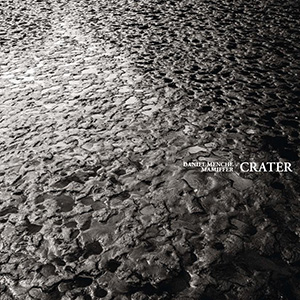 Mamiffer, the duo of Faith Coloccia and Aaron Turner, have recorded with a slew of artists who work in similarly contrasting fields of noise and music, but this is the first true work with Pacific Northwest neighbor and the world’s loudest school librarian, Daniel Menche. A previous release, "Live" Through Menche featured him reworking Coloccia and Turner's recorded work as a performance, but Crater is the first time they have truly worked together on record. A mix of live instrumentation, processed field recordings, and who knows what (other than the artists), the resulting record is anything but boisterous, explosive noise and instead a careful meditation on both nature and music.
Mamiffer, the duo of Faith Coloccia and Aaron Turner, have recorded with a slew of artists who work in similarly contrasting fields of noise and music, but this is the first true work with Pacific Northwest neighbor and the world’s loudest school librarian, Daniel Menche. A previous release, "Live" Through Menche featured him reworking Coloccia and Turner's recorded work as a performance, but Crater is the first time they have truly worked together on record. A mix of live instrumentation, processed field recordings, and who knows what (other than the artists), the resulting record is anything but boisterous, explosive noise and instead a careful meditation on both nature and music.
The album's bookending pieces, "Calyx" and "Maar," make for the two most conventionally musical songs on the album.Both feature Turner's guitar and Coloccia's piano playing complimentary melodies, as processing (by I assume the hand of Menche) pushes both into distorted, at times abrasive territory, and then back again.Even though the resulting sound is by no means traditionally beautiful, that hint of chaos is a splendid additional facet to the songs.
The lengthier pieces that make up the core of the record feature significantly less in the way of traditional instrumentation.The dynamic, textural opening to "Husk" is culled from the field recordings with little to no treatment, but retain enough ambiguity to render them largely unidentifiable.Expanding tones of fragmented guitar are layered about, with shifting pitches keeping everything varied.While the piece never becomes overly sinister, there is a distinct heavy tension running through its 14 minute duration.
On "Exuviae," the trio uses a more obvious field recording (that of rushing water) with distant drumming and shimmering, droning expanses of sound.Hints of distortion color what sounds like bowed strings, but the sound stays beautiful, if a bit dark.A nuanced analog sound is heavily featured on "Alluvial", with subtle cracking blended with ghostly tones and chiming church bell-like layers.The piece evolves in to a massive leviathan of shimmering noise and orchestral drama that is as imposing as it is beautiful.
Compared to the rest of the album, "Breccia" shows less evolution and development, but it is in the subtle changes that it is very strong.An opening of what sounds like scraping wood makes for a murky beginning, soon met with a processed wall of guitar noise.Filtered and kept at bay at a reasonable volume level, it is less of an outburst than it is a forceful counterpoint to the ambience.While what sounds like a wall of dissonance is established via guitar and electronics from Turner and Menche, Coloccia adds in an ever so quiet layer of twinkling piano that beautifully ties the entire piece together.
For a record that was created by, as Menche puts it, friends just hanging out, recording and then eating pizza, Crater has a massive number of layers, both sonically and in mood as well, that belie its humble origin.Moods shift from gawking at beautiful soundscapes to disquieting, imposing monsters of heaviness lurking in the shadows.But never does Crater drag, and there is not a dull moment to be had as these three amazing artists perform together brilliantly.
samples:
 
Read More
- Administrator
- Albums and Singles
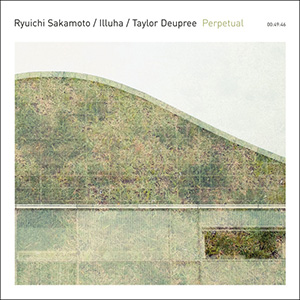 These two recent collaborations featuring Taylor Deupree capture two distinct extremes in his approach to creating music. Perpetual, his collaboration with legendary pianist Ryuichi Sakamoto and the duo of Illuha is a four-piece ensemble using piano, guitar, modular synthesizer, and other conventional instruments to create a delicate, complex and almost living composition. Twine, an in-studio performance with Marcus Fischer is a much simpler affair, with the two manipulating tape loops in real time, recorded live with just room microphones capturing the performance. One may be a larger production and the other an intimate performance, but both are superb documents of Deupree's (and the other performers') sense of small scale, but infinitely detailed and varied music.
These two recent collaborations featuring Taylor Deupree capture two distinct extremes in his approach to creating music. Perpetual, his collaboration with legendary pianist Ryuichi Sakamoto and the duo of Illuha is a four-piece ensemble using piano, guitar, modular synthesizer, and other conventional instruments to create a delicate, complex and almost living composition. Twine, an in-studio performance with Marcus Fischer is a much simpler affair, with the two manipulating tape loops in real time, recorded live with just room microphones capturing the performance. One may be a larger production and the other an intimate performance, but both are superb documents of Deupree's (and the other performers') sense of small scale, but infinitely detailed and varied music.
Perpetual is presented as a three movement composition that progresses adeptly from soft melodies and tones into a wider reaching feel of dissonance, then back to spacious, open, and beautiful music.The first movement has the quartet generating delicate, warm layers from their stringed and synthetic instruments.Fragments of voice, and a bit of electronic buzzing offset the carefully interplaying frequencies, resulting in a lush, tone-heavy arrangement of sound.
The second part still features Sakamoto's distinctive piano, but his playing focuses on the lowest notes and the recording perfectly capturing the metallic, vibrating dissonance of the strings.This hint of chaos sets the stage for the remainder of the piece.Odd noises and unexpectedly bleak music box sounds appear, withe the artists blending organic and electronic sources extremely well.Deupree's modular synthesizer performance introduces just the right amount of chirps and noisy scrapes to give the piece an appropriately hollow, slightly bleak feel.The final movement is a natural progression from the previous, where the artists begin with clattering sounds, but they bring the sound back to the opening via pure guitar and piano sounds, creating a spacious, yet delicate sound.
samples:
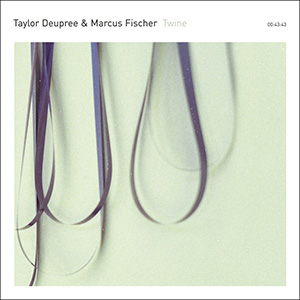 The comparatively stripped down arrangements Deupree and Marcus Fischer create on Twine result in compositions that are not quite as varied or diverse, but unsurprisingly they pull refined beauty from the two lengths of magnetic tape they manipulate.Some of the compositions are largely defined by the imperfections and idiosyncrasies of the recording medium they work with rather than what is pre-recorded."Bell" would seem to be based on recordings of, well, bells, but the specifically discernible sounds are all buried under the noise of tape.What may be a simple series of repeated tones become something much more captivating as they work in crackling and distortion in addition to the sounds from the manipulated tape.On "Draw" the duo utilize the wavering, inconsistent tones that can be culled from analog equipment to excellent effect.
The comparatively stripped down arrangements Deupree and Marcus Fischer create on Twine result in compositions that are not quite as varied or diverse, but unsurprisingly they pull refined beauty from the two lengths of magnetic tape they manipulate.Some of the compositions are largely defined by the imperfections and idiosyncrasies of the recording medium they work with rather than what is pre-recorded."Bell" would seem to be based on recordings of, well, bells, but the specifically discernible sounds are all buried under the noise of tape.What may be a simple series of repeated tones become something much more captivating as they work in crackling and distortion in addition to the sounds from the manipulated tape.On "Draw" the duo utilize the wavering, inconsistent tones that can be culled from analog equipment to excellent effect.
"Buoy" is another example where the two put a greater emphasis on the sound of the equipment more than the existing recordings.With a bit of buzz and some metallic knocking (which I just assume is the mechanics of the tape players they are using), soft notes contrast the equipment's jagged looseness and imperfections very well."Sailmaker" too has Deupree and Fischer just barely flirting with melody; instead the slowed down sounds and mechanical noises becoming the focus of the piece.It is only on "Telegraph" and "Wake" where the recorded source material seems to be the focus of the compositions.The former sounds again like the two manipulating loops of bells and chimes, but the focus is placed more on these gentle sounds as opposed to manipulating the delivery system."Wake" closes the album, and there seems to be clearer sounds of guitar or other stringed instruments coming through the mix, with lots of open space and incidental sounds within the loops.There is not a lot of raw material utilized in the piece, but the duo generate amazing sounds and moods from that basic formula.
Taylor Deupree has done an amazing job at curating the 12k label since its inception, presenting music that may not always be similar to his, but always reflects his ear for rich compositions created from the most hushed of sounds.Whenever he does release his own work, however, the result is never a disappointment and just a reiteration of his expertise at this style of composition.These two albums may differ in their methods and composition techniques, but that common thread between them, Deupree himself, is what makes for two beautiful, understated compositions that do so much with the barest of sonic ingredients.
samples:
 
Read More
- Administrator
- Albums and Singles
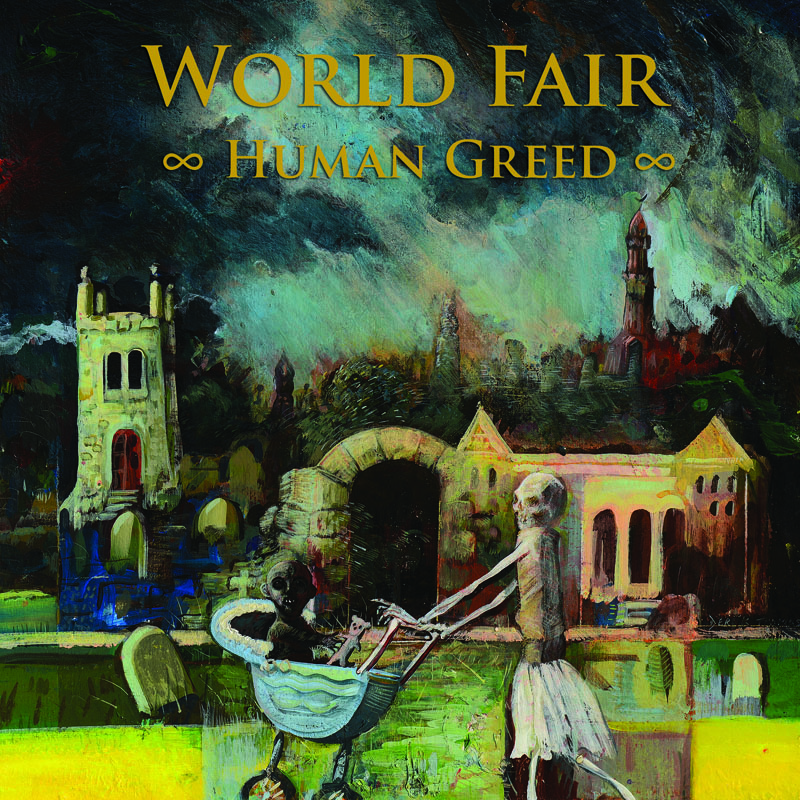 This latest album is astonishing even by the high standards I would have held Michael Begg to. Combining the normally distinct worlds of theology and thermodynamics, World Fair is a formidable work that rewards careful listening and engagement with the material. The heavy and daring philosophical musings are lifted by the stunning music created by Begg and his friends (including the return of Deryk Thomas to make Human Greed a duo once more). Altogether, they have made manifest an album of rare power that feels like it has years of epiphanies buried within it.
This latest album is astonishing even by the high standards I would have held Michael Begg to. Combining the normally distinct worlds of theology and thermodynamics, World Fair is a formidable work that rewards careful listening and engagement with the material. The heavy and daring philosophical musings are lifted by the stunning music created by Begg and his friends (including the return of Deryk Thomas to make Human Greed a duo once more). Altogether, they have made manifest an album of rare power that feels like it has years of epiphanies buried within it.
Following an extended instrumental prelude with all the usual hallmarks of Human Greed (rich textures and aching drones), a voice suddenly emerges from the gloom on "Waiting in a Car." Nicole Boitos (probably best known to Brainwashed readers as the artist responsible for the lamb on the cover of Human Greed’s previous album, Fortress Longing, and The Body Lovers among many other great works) reads the text that lives at the center of World Fair and sets its thesis out: the meeting of thermodynamics and divinity or at least treating thermodynamics as something that a person could have spiritual faith in. Boitos recites the words with a tempered delivery, both reverential and humane. Here, Begg nails his colors to the mast in what he is attempting to do; to approach the world of physics through the lens of theology.
Throughout the album, the thermodynamic concept of entropy (the tendency towards thermodynamic equilibrium; generally meaning towards a disordered state) and the related idea of heat death (the proposed final outcome of thermodynamics where the entropy of the universe reaches its absolute maximum). On the surface, these theories seem as far fetched as anything in theology and on the surface the language of physics lends itself to comparisons and metaphors with the singularity of the Big Bang becoming representative of many creation stories ("In the beginning was the Word," the idea that the word "Om" is the original vibration from which all else came, etc.) and the fiery images brought to mind from the phrase "Heat death" are all apocalyptic. Even the general understanding of entropy as a process away from the organization laid out at the beginning of the universe can easily be morphed into concepts of higher states, divine harmony and temptation towards destruction. Therefore, the text that appears again and again can be seen as much as a prayer as anything. On World Fair, Christ becomes Chrysler (the history of the motor car is fully entwined with the development of thermodynamics) and physics and metaphysics blur.
To underline the thermodivinic themes of the album, Begg sets a foot in the past as well as the present, drawing as much on Thomas Tallis and John Taverner and early Georgian chant as he does on contemporary musical techniques and styles. This feeds deeper into the metaphor at the heart of the album. Begg’s assimilation of these early musics in the same way energy is transferred from one form to another (even the word "metaphor" itself carries thermodynamic baggage, coming from the Greek meaning "to transfer"). These feelings explored by those long dead cannot be destroyed, they just take on new forms (and maybe the same can be said for the feelings that first gave rise to religion becoming transferred to a scientific understanding of the universe).
As the rich and melancholic elegance of the music of the 1500s resonates profoundly through World Fair, its effect is intensified by the sounds of church bells and birds coming together to create a calming sense of nature, acting as a medium to explore a time before the city as a dominating force existed.To take this further, one of the album’s most poignant moments comes during "From Olden Disks" via a recording of a man with a thick southern United States accent talking about walking out to the woods to experience the purest feeling of peace. His genuine awe at the restorative potential of being alone in nature is truly moving. This well-trodden metaphor of nature as salve for the soul becomes magnified as World Fair goes on, the cataclysmic finale of heat death instead becomes more faithful to its proper, mathematical meaning as everything reaches a state of equilibrium and quantum nirvana is achieved.
samples:
 
 
Read More
- Administrator
- Albums and Singles
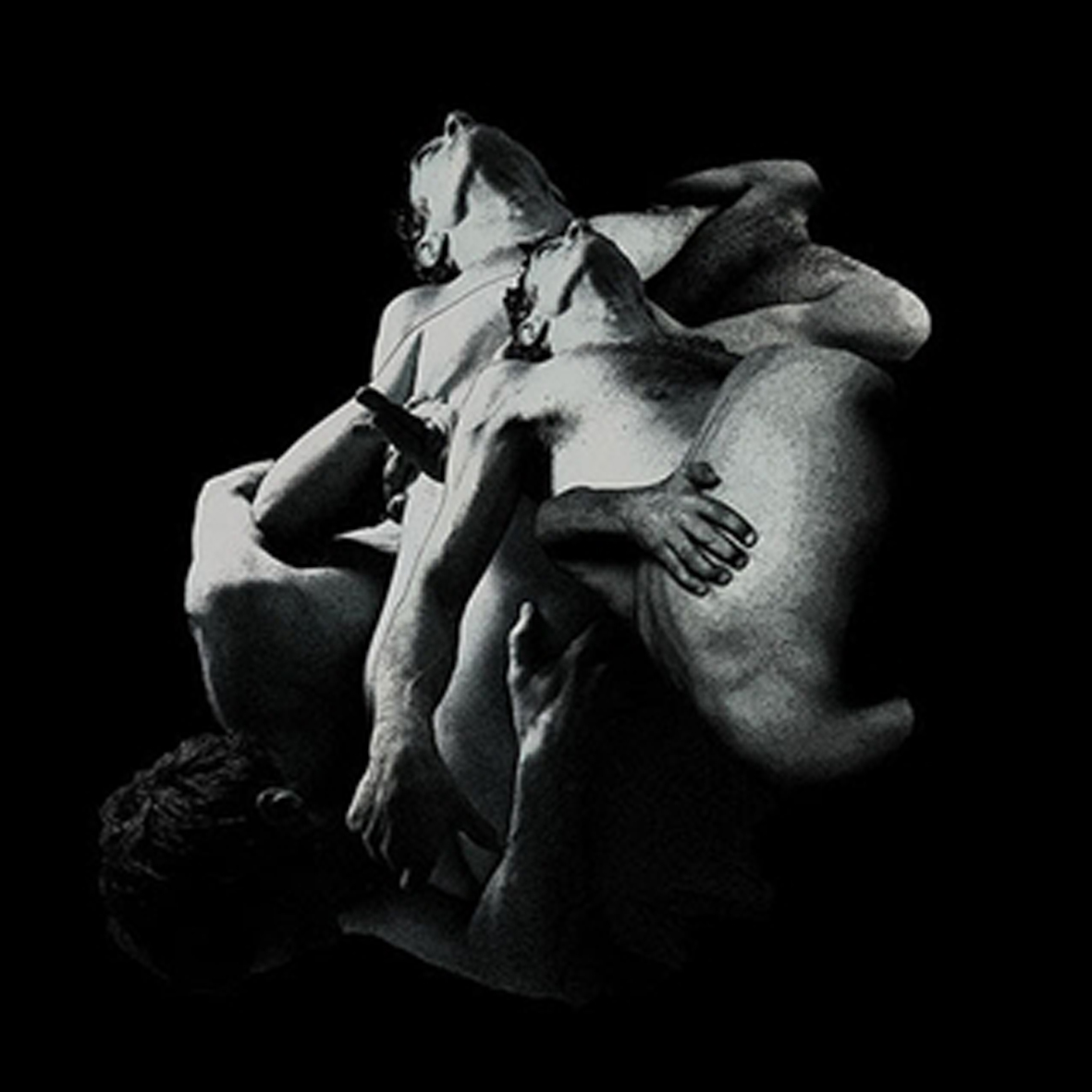 I have been following Vessel since 2012's Order of Noise album, as Seb Gainsborough always seemed like one of the most consistently compelling and distinctive forces in Bristol’s Livity Sound/Young Echo scene.  Somehow, however, his albums always fell just short of being something I could get truly excited about.  Punish, Honey admittedly continues that trend in some ways, but it is a huge evolution in others, as Gainsborough has largely untangled himself from current underground dance trends and embraced some very unhinged, adventurous, and heavy new textures.
I have been following Vessel since 2012's Order of Noise album, as Seb Gainsborough always seemed like one of the most consistently compelling and distinctive forces in Bristol’s Livity Sound/Young Echo scene.  Somehow, however, his albums always fell just short of being something I could get truly excited about.  Punish, Honey admittedly continues that trend in some ways, but it is a huge evolution in others, as Gainsborough has largely untangled himself from current underground dance trends and embraced some very unhinged, adventurous, and heavy new textures.
Vessel's impressive transformation from techno to the fringe-y outer limits is amply apparent within the very first minute of Punish, Honey, as the brief "Febrile" launches into a snare roll that sounds like an actual, untreated drum kit before exploding into full-on jackhammer industrial chaos.  Gainsborough tones down the violence with the first "real" song ("Red Sex"), but compensates with an inspired juxtaposition of machine noise rhythms; a slinky, lurching tom-tom beat; and a very warped-sounding synth hook.  To his eternal credit, Seb somehow finds a way to make his synth sound even more spectacularly wrong for a mid-song interlude.  The overall effect resembles a weirdly anthemic take on Love’s Secret Domain-era Coil or something that would be played at a strip club in a sci-fi dystopia.  While, "Red Sex" is not particularly representative of the rest of the album stylistically, it is nevertheless a strong and clear statement of intent: Gainsborough seems both actively intent on subverting expectations and utterly indifferent to the possible alienation of his previous fan-base.  The gauntlet has been thrown down: Punish, Honey is absolutely not going to be just another techno album in any conventional sense.
The rest of the album is spent ingeniously twisting Vessel's core sound into unexpected new forms.  For example, "Drowned in Water and Light" marries deep bass throb with melancholy groaning strings and a harsh metallic shimmer to create something resembling a ritualistic funeral march. ""Euoi," on the other hand, sounds like blown-out, overdriven, and fractured minimalism set to a stumbling, slow-motion groove.  Another stand-out is "Anima," which initially sounds like rolling, thumping twist on Suicide before its simple, thick synth motif is gradually subsumed by layers and layers of counter-melodies and electronics.  Bizarrely, it transforms into fairly straightforward '90s industrial dance at one point, before transforming yet again into something that sounds like an English folk dance played backwards through a pile-up of studio effects.  Perhaps the finest moments on the album, however, belong to "Black Leaves and Fallen Branches," which reprises the "ritualistic funeral march" aesthetic of "Drowned," but beautifully echoes the main melody with textures that sound distant, surreal, and extra-dimensional.  It certainly has some lulls, but its high points are singularly, gloriously fucked in all the right ways.
For all its brilliance, "Black Leaves and Fallen Branches" is also a piece that highlights the only real flaw with Punish, Honey: Seb's talents as a composer currently lag a bit behind his other gifts.  Despite its audacious and wonderfully crazy ideas, wild sounds, and beautifully realized textures and arrangements, this album is curiously lacking in great songs to show for it: there are plenty of momentum-sapping lulls between highlights and nearly every song feels more like a vamp based upon a single great motif than a composition with serious depth.  That said, Punish, Honey nevertheless wildly exceeded my expectations in nearly every other way, as I never would have expected Seb to turn out anything quite as singular and forward-thinking as this.  I would not exactly say that I was blown out of my chair when I first put this album on, but my eyes definitely widened immediately and had to check to make sure that I was actually listening to a Vessel album (I was).  It may not be quite perfect, but Punish, Honey is a massive, attention-grabbing leap forward for Gainsborough.
 
 
Read More
- Administrator
- Albums and Singles

Artist: Burial Hex / Iron Fist Of The Sun
Title: Actaeon / Grown Under English Ice
Catalogue No: CSR153LP
Barcode: 8 2356650652 2
Format: LP
Genre: Power Electronics / Death Industrial
Shipping: Now
Order LP
Superb trans-Atlantic Power Electronics / Death Industrial face-off between Wisconsin's Burial Hex and Birmingham's Iron Fist Of The Sun. Burial Hex presents 2 "pre-industrial" conceptual compositions. Aside from one synth at the end of the first track, this music was all made with acoustic sounds. Intense Power Electronics, but without using amplification or electronically generated sounds. Just like how many industrial artists have flirted with depicting sounds and atmospheres from the first and second World Wars, these pieces were composed imaging atmospheres closer to the American Civil War era. IFOTS's 4 tracks were recorded at Crushing Obelisk, Birmingham, England. Dedicated to betrayers of family / faith / country. 40 minutes. Ltd x 500 copies.
Tracks: 1. The Coming Of War | 2. Act Aeon | 3. This Man WIll Glow / Two Circles Of Salt | 4. Hessianmud | 5. The 5th Wife | 6. Grown Under Ice
Read More


